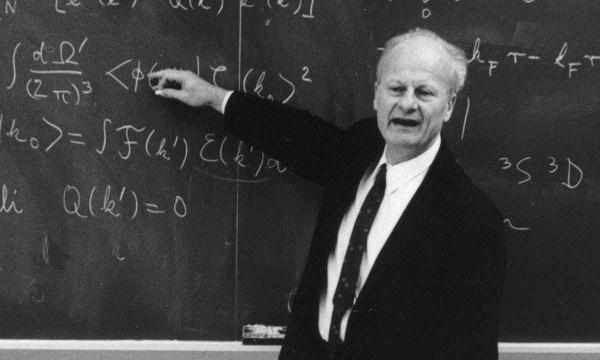Nuclear Fusion Theory
Nuclear fusion is a reaction in which two or more atomic nuclei are combined to form one or more different atomic nuclei and subatomic particles (neutrons or protons). The difference in mass between the reactants and products is manifested as either the release or absorption of energy. This difference in mass arises due to the difference in atomic "binding energy" between the atomic nuclei before and after the reaction. Fusion is the process that powers active or "main sequence" stars, or other high magnitude stars.
A fusion process that produces a nucleus lighter than iron-56 or nickel-62 will generally yield a net energy release. These elements have the smallest mass per nucleon and the largest binding energy per nucleon, respectively. Fusion of light elements toward these releases energy (an exothermic process), while a fusion producing nuclei heavier than these elements will result in energy retained by the resulting nucleons, and the resulting reaction is endothermic.
Physicists at the turn of the 20th century realized that the existing paradigm for stellar energy production was wrong. The old theory, that the sun’s energy was produced by gravitational contraction, could supply only 30 million years of stellar energy, but biologists and geologists were estimating the earth was much older. Since the earth could not predate the sun, a much more copious energy source was needed.
A long series of discoveries beginning with Einstein’s relativity in 1905 led up to Bethe’s discovery of the correct nuclear reactions. Hydrogen fusion seemed like a good candidate because according to E = mc2.
Hans Albrecht Bethe worked out two nuclear reaction mechanisms whereby fusion would occur. In one mechanism, two protons fuse together as one transforms into a neutron to form a so-called deuteron. The deuteron captures a proton, making a helium-3 nucleus, which further reacts to produce helium-4. The other mechanism, called the C-N-O cycle, assumes a small amount of carbon is present to catalyze a reaction chain that involves nitrogen and oxygen intermediaries and ultimately produces helium nuclei from protons.

The nuclear reaction that will happen to explain the melting of the nucleus of Hydrogen in Helium depends on the temperature inside the star. In the stars with smaller masses the proton-proton chain occurs, in the stars with larger masses the carbon cycle occurs and when the helium has already been formed and is at a very high temperature the triple-alpha process occurs.
PROTON-PROTON CHAIN: The temperature for this chain to occur must be less than 106 K. Two hydrogen atoms come together to form a deuterium, a positron, and a neutrino.
The neutrino quickly exits the star, the positron encounters an electron and they annihilate and release energy.
Then the deuterium nucleus joins with another Hydrogen atom, transforming itself into an isotope of Helium releasing more luminous energy in the form of photons. And in the end, two isotopes come together and form a helium atom.

CNO CYCLE: This cycle begins with the fusion of hydrogen with a carbon nucleus and after successive reactions, where four nuclei of hydrogen, carbon, nitrogen and oxygen, can reach a nucleus of Helium and one of carbon, being that during the reactions light energy is released, the photons.

TRIPLE-ALPHA: This process consists of the production of carbon inside the stars as temperatures above 108 K, using three nuclei of Helium is formed carbon nucleus.
This process is called this way, because the helium nucleus is called the "alpha particle" and after the reactions that occur, the carbon and the alpha particle are formed.
While Bethe correctly identified the two possible mechanisms of solar fusion, he incorrectly judged which was responsible for energy production in our sun. “The most important source of energy in ordinary stars,” he wrote in the first sentence of the second paper, “is the reaction of carbon and nitrogen with protons.”
Bethe concluded that proton-proton fusion dominates energy production only in stars that are about 1000 times fainter than the sun. The problem was that in the 1930s, the sun’s core temperature "was" thought to be about 20 million degrees. The true temperature is closer to 14 million degrees. We now know that proton-proton fusion is the energy source of our sun. Only in more massive stars is the C-N-O cycle relevant.
This mistake hardly marred the significance of the work, which led to his Nobel Prize. Among scientists, “credit for hitting the right reaction chain goes to Bethe,” but Carl Friedrich von Weizsäcker came up with the same results at the same time in Germany, though his work was not known in the United States until after World War II.
Following Bethe’s work, astrophysicists were able to work out many details of stellar physics, which led to a view of stars almost as living beings. As Bethe concluded his Nobel lecture, “Stars have a life cycle much like animals. They get born, they grow, they go through a definite internal development, and finally they die, to give back the material of which they are made, so that new stars may live.”
Bethe's paper: Energy Production in Stars



REFERENCES
American Physical Society. Available in: https://physics.aps.org/story/v21/st3. Access in: 30/09/2018.
Wikipedia. Available in: https://en.wikipedia.org/wiki/Nuclear_fusion. Access in: 30/09/2018.
Encyclopædia Britannica. Available in: https://www.britannica.com/biography/Hans-Bethe. Access in: 30/09/2018.




















































































0 comments
Sign in or create a free account